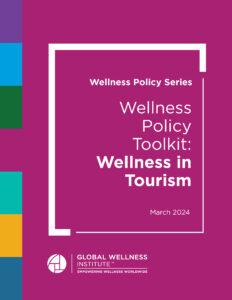Media Contact: Beth McGroarty
[email protected] • +1.213.300.0107
All GWI Press Releases | Press Image Gallery | Global Wellness Institute Press Room | Global Wellness Summit
Global Wellness Institute Releases Wellness Policy Toolkit That Proposes an Entirely New Paradigm, Moving the Focus from Wellness Tourism to Wellness IN Tourism
The report presents policy ideas that move beyond the narrow goals of attracting luxury resorts and wealthy tourists to strategies that would bring more wellbeing to all—travelers, residents, and the destination. GWI also releases first compilation of wellness tourism market data, 2012-2027

Miami, FL – March 27, 2024 – The non-profit Global Wellness Institute (GWI), the leading research organization for the wellness industry, today released a new report, Wellness Policy Toolkit: Wellness in Tourism. It’s the latest in GWI’s policy series, and puts forth numerous actions for every stakeholder—whether government or travel industry leaders—to bring wellness to all in the context of tourism.
Importantly, the report introduces a new paradigm, which broadens the focus from wellness tourism to wellness IN tourism.
As such, the toolkit does not rehash wellness tourism strategies that focus on developing luxury spa resorts and bringing in high-spend tourists. Rather, the aim is to unite the concepts of wellness and tourism in the broadest possible sense, and to present policy ideas that help everyone. It outlines numerous strategies that would enhance the quality of place for tourists, make tourism more successful and, at the same time, improve the wellbeing of both local residents and the destination. The report identifies six key barriers currently preventing wellness tourism from delivering those broader-based health and wellbeing benefits, and details six areas of policy action that could solve for those problems.
“Wellness tourism does not exist in a vacuum and wellness travelers cannot be confined to a bubble,” said Ophelia Yeung, GWI senior research fellow. “For those who want to succeed long-term in wellness tourism, it is only logical to focus more attention on the wellness of the place—including the local wellness infrastructure, the wellness of its people, and the destination.”
DOWNLOAD the full (free) report here.
Who is this toolkit for? It’s designed to help anyone interested in policy approaches that embed wellness broadly into tourism, placemaking, and local development. The strategies presented cut across wellness tourism, sustainable and responsible tourism, equitable wellness, quality of life, placemaking, and “placekeeping.” As such, they can be pursued by those working in hospitality and tourism businesses, tourism promotion, destination management, economic development, or by those representing the wellbeing of workers and the community, and the protection of cultural heritage and the environment.
Six problems confronting wellness tourism, and policy actions that can tackle them:
The heart of the toolkit is laying out the key obstacles preventing wellness tourism from delivering broad-based health and wellbeing benefits to local destinations, residents and tourists. The report then outlines a wide array of policy actions that can address each issue.
- Problem: Many businesses, governments, communities and travelers have a very narrow understanding of wellness tourism and its potential.
Policy actions that expand the reach and impact of wellness tourism.
- Problem: Wellness tourism offerings are often siloed and separated from local consumers, businesses and communities.
Policy actions that integrate the local economy with the wellness tourism economy.
- Problem: The people working to improve the wellness of others are not well themselves.
Policy actions that improve the wellness of the tourism workforce.
- Problem: Destinations and local communities are often the collateral damage of the tourism economy, including wellness tourism.
Policy actions that embed equity and sustainability in wellness tourism development and stewardship.
- Problem: Rapidly evolving wellness sectors challenge governments and policies to keep up.
Policy actions that support wellness tourism with up-to-date wellness market knowledge and regulations.
- Problem: Technology is pervasive in tourism, but it does not always enhance the wellness or experiences of tourists.
Policy actions that ensure that technology enhances wellbeing for travelers.
New datasets on the wellness tourism market:
To put the opportunity in context, the GWI today also released a first-ever time-series dataset on the wellness tourism market (from 2012 to 2022, and projecting forward to 2027). This compilation of 15 years of data provides a clear snapshot of wellness tourism’s explosive growth and how it’s a powerful, enduring travel trend that will continue to reshape the tourism industry.
The dataset provides a clear historical view of global wellness tourism revenue growth: surging from $439 billion in 2012 to $651 billion in 2022—and expected to more than double by 2027, to $1.4 trillion. It spotlights the growth in wellness trips worldwide: from 524 million in 2012 to 819 million in 2022, and expected to reach 1.63 trillion by 2027. It compares wellness tourism growth rates to overall tourism growth: pre-pandemic, during the pandemic, in the pandemic recovery years, and with a future projection through 2027. It shows how wellness tourism trips make up an ever-growing percentage of all tourism trips: expanding from 5.8% in 2012 to 7.75% in 2022, and expected to reach 8.3% by 2027. And, finally, it lays out the shifting spending premiums for both domestic and international wellness tourists over the last decade.
Access the new datasets and graphs HERE.
REGISTER to watch today’s GWI Master Class on wellness tourism, where the report’s authors unveil key insights from the toolkit and provide new analysis of the market.
About the Global Wellness Institute: The Global Wellness Institute (GWI), a nonprofit 501(c)(3), is considered the leading global research and educational resource for the global wellness industry and is known for introducing major industry initiatives and regional events that bring together leaders to chart the future. GWI positively impacts global health and wellness by educating public institutions, businesses and individuals on how they can work to prevent disease, reduce stress, and enhance the overall quality of life. Its mission is to empower wellness worldwide.
























































